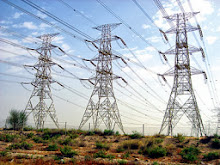Speed Control of Induction Motors & Speed Control
Speed Control of Induction Motors
Recall the equation
for synchronous speed:
Ns = 120 f / p
Therefore, to control
the speed of an induction
Motor, we can control
the frequency of the
Supply. Changing the
frequency changes the
Nominal speed
of the machine.
However, we also want
to keep the flux (Ö) in the
Machine at the design
value. Recall the flux
Linking equation:
V = 4.44 Ö N f
· Pole Changing
Early machines were designing with multiple poles to
facilitate speed control by pole changing. By switching in different numbers or
combinations of poles, a limited number of fixed speeds could be obtaining.
· Variable Rotor Resistance
The speed of induction motors can however be varied
over a limited range by varying the rotor resistance as noted in the section on slip
but only by using wound rotor designs negating many of the advantages of the
induction motor.
· Variable Frequency
Since motor speed depends on the speed of the rotating
field, speed control can be effecting by changing the frequency of the AC power
supplied to the motor.
As in most machines, the induction motor is designed
to work with the flux density just below the saturation point over most of its operating range to achieve optimum
efficiency.
B = K2 (V/f)
Where V is the applied voltage, f is the supply
frequency and k2 is a constant depending on the shape and
configuration of the stator poles.
In other words if the flux density is constant, the
Volts per Hertz is also a constant. This is an important relationship and it
has the following consequences.
- For speed control, the supply voltage must increase in step with the frequency; otherwise, the flux in the machine will deviate from the desired optimum operating point. Practical motor controllers based on frequency control must therefore have a means of simultaneously controlling the motor supply voltage. This is known as Volts/Hertz control.
- Increasing the frequency without increasing the voltage will cause a reduction of the flux in the magnetic circuit thus reducing the motor's output torque. The reduced motor torque will tend to increase the slip with respect to the new supply frequency. This in turn causes a greater current to flow in the stator, increasing the IR volt drop across the windings as well as the I2R copper losses in the windings. The result is a major drop in the motor efficiency. Increasing the frequency still further will ultimately cause the motor to stall.
- Increasing the voltage without
increasing the frequency will cause the material in the magnetic circuit
to saturate. Excessive current will flow giving rise to high heat
dissipation due to I2R losses in the windings and high eddy
current losses in the magnetic circuit and ultimately failure of the motor
due to overheating. Increasing the voltage will not force the motor to
exceed the synchronous speed because as it approaches the synchronous
speed the torque drops to zero.
The variable frequency is normally providing by an . inverter.See more about motor control
Note also that since the induced current in the rotor is proportional to the flux density and the flux density in turn is proportional to the line
voltage, the torque, which depends on the product of the flux density and the
rotor current, is proportional to the square of the line voltage V.
V/f CONTROL
THEORY
As we can see in the
speed-torque characteristics, the
Induction motor draws
the rated current and delivers
The rated torque at
the base speed. When the load is
Increased (over-rated
load), while running at base
Speed, the speed
drops and the slip increases. As we
Have seen in the
earlier section, the motor can take up
To 2.5 times the
rated torque with around 20% drop in
the speed. Any
further increase of load on the shaft
Can stall the motor.
The torque developed
by the motor is directly
Proportional to the
magnetic field produced by the stator.
Therefore, the
voltage applied to the stator is directly
Proportional to the
product of stator flux and angular velocity.
This makes the flux
produced by the stator
Proportional to the
ratio of applied voltage and frequency of supply.
By varying the
frequency, the speed of the motor can
Be varied. Therefore,
by varying the voltage and
Frequency by the same
ratio, flux and hence, the
Torque can be kept
constant throughout the speed range.
Clearly, Ö is proportional to V
/ f. Therefore, as we
vary the frequency,
we must also vary the
voltage in
proportion. (Volts per Hertz Rule)
The effect of VVVF
speed control is to retain the
shape of the
torque-speed curve, but shift it
along the
speed axis.
*For VVVF control,
because the shape of the
Torque-speed curve is
the same at all
frequencies, it
follows that the torque
of an
induction motor is the same whenever the
slip speed (rpm) is the same.
Slip speed =
Synchronous Speed – Actual Speed
• With VVVF control, the speed range
possible is from
about 10% to 150% of
rated speed.
• Below 10% of rated
speed, the volts per hertz ratio
has to be
progressively increased to compensate for
the IR drop in the
stator. This is because at very low
frequencies the
stator resistance dominates the
magnetizing reluctance
(= 2 ð f
L).
• Above rated the
speed is limited by centrifugal
. forces on
the rotor
• To implement VVVF control we need a
VVVF AC supply
• A supply of this
nature is realized with
power
electronics
Typical torque curves for different line
frequencies. By varying the line frequency with an inverter, induction motors
can be kept on the stable part of the torque curve above the peak over a wide
range of rotation speeds. However, the inverters can be expensive, and fixed
line frequencies and other start up schemes are often employed instead.













0 comments:
Post a Comment